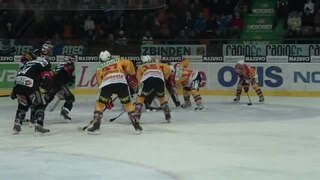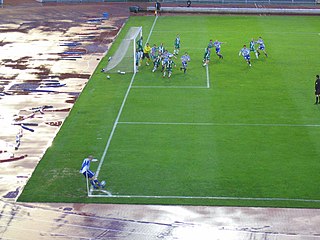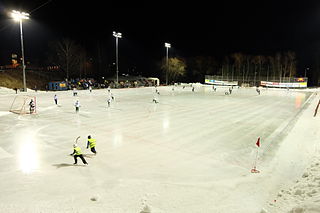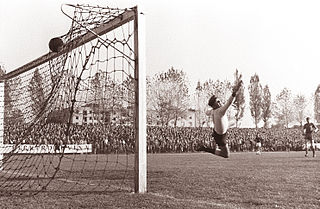
Bandy is a team winter sport played on ice, in which skaters use sticks to direct a ball into the opposing team's goal.

In many team sports which involve scoring goals, the goalkeeper is a designated player charged with directly preventing the opposing team from scoring by blocking or intercepting opposing shots on goal that kicks the ball from the other player.

Offside is one of the laws of association football, codified in Law 11 of the Laws of the Game. The law states that a player is in an offside position if any of their body parts, except the hands and arms, are in the opponents' half of the pitch, and closer to the opponents' goal line than both the ball and the second-last opponent.

A penalty kick is a method of restarting play in association football, in which a player is allowed to take a single shot on the goal while it is defended only by the opposing team's goalkeeper. It is awarded when a foul punishable by a direct free kick is committed by a player in their own penalty area. The shot is taken from the penalty mark, which is 11 m from the goal line and centred between the touch lines.

A face-off is the method used to begin and restart play after goals in some sports using sticks, primarily ice hockey, bandy and lacrosse. The two teams line up in opposition to each other, and the opposing players attempt to gain control of the puck or ball after it is dropped or otherwise placed between their sticks by an official.
The Laws of the Game (LOTG) are the codified rules of association football. The laws mention the number of players a team should have, the game length, the size of the field and ball, the type and nature of fouls that referees may penalise, the frequently misinterpreted offside law, and many other laws that define the sport. During a match, it is the task of the referee to interpret and enforce the Laws of the Game.
In rugby football, the penalty is the main disciplinary sanction available to the referee to penalise players who commit deliberate infringements. The team who did not commit the infringement are given possession of the ball and may either kick it towards touch, attempt a place kick at goal, or tap the ball with their foot and run it. It is also sometimes used as shorthand for penalty goal.

A corner kick is the method of restarting play in a game of association football when the ball goes out of play over the goal line, without a goal being scored and having last been touched by a member of the defending team. The kick is taken from the corner of the field of play nearest to where it went out. Corners are considered to be a reasonable goal scoring opportunity for the attacking side, though not as much as a penalty kick or a direct free kick near the edge of the penalty area.

A goal kick, called a goalie kick in some regions, is a method of restarting play in a game of association football. Its procedure is dictated by Law 16 of the Laws of the Game.

A throw-in is a method of restarting play in a game of association football when the ball has exited the side of the field of play. It is governed by Law 15 of The Laws Of The Game.

In the sport of association football, fouls and misconduct are acts committed by players which are deemed by the referee to be unfair and are subsequently penalised. An offence may be a foul, misconduct or both depending on the nature of the offence and the circumstances in which it occurs. Fouls and misconduct are addressed in Law 12 of the Laws of the Game.

A penalty shot or penalty kick is a play used in several sports whereby a goal is attempted during untimed play. Depending on the sport, when a player commits certain types of penalties, the opposition is awarded a penalty shot or kick attempt. The rules on how a player attempts a penalty shot or kick also varies between sports.
Rugby union is a team sport played between two teams of fifteen players.
This list of rugby league terms is a general glossary of the terminology used in the sport of rugby league football. The sport has accrued a considerable amount of jargon to describe aspects of the game. Many terms originate from the Laws of the Game. A number of aspects of the game have more than one term that refers to them. Different terms have become popularly used to describe an aspect of the game in different places with notable differences between the northern and southern hemispheres.
A penalty in rugby union is the main disciplinary sanction available to the referee to penalise a team who commit deliberate infringements. The team who did not commit the infringement are given possession of the ball and they may either kick it towards touch, attempt a place kick at goal, or tap the ball with their foot and run. It is also sometimes used as shorthand for penalty goal.

A bandy field or bandy rink is an ice rink used for playing bandy.

Ringball is a traditional South African sport that stems from basketball and has been played since 1907. The sport is now promoted in South Africa, Namibia, Botswana, Lesotho, India, and Mauritius to establish Ringball as an international sport. The sport is played by both men and women teams.

In games of association football teams compete to score the most goals during the match. A goal is scored when the ball passes completely over a goal line at either end of the field of play between two centrally positioned upright goal posts 24 feet (7.32 m) apart and underneath a horizontal crossbar at a height of 8 feet (2.44 m) — this frame is itself referred to as a goal. Each team aims to score at one end of the pitch, while preventing their opponents from scoring at the other. Nets are usually attached to the goal frame to catch goalscoring balls, but the ball is not required to touch the net.

Futsal began in the 1930s in South America as a version of association football, taking elements of its parent game into an indoor format so players could still play during inclement weather. Over the years, both sports have developed, creating a situation where the two sports share common traits while also hosting various differences.

A free kick is a method of restarting play in association football. It is awarded after an infringement of the laws by the opposing team.















